Adapiformes
Adapiformes are an extinct group of early primates. Adapiformes radiated throughout much of the northern continental mass, reaching as far south as northern Africa and tropical Asia. They lived from the Eocene to the Miocene epochs. Some adapiformes looked similar to living lemurs.
| Adapiformes | |
|---|---|

| |
| Notharctus tenebrosus | |
| Scientific classification | |
| Domain: | Eukaryota |
| Kingdom: | Animalia |
| Phylum: | Chordata |
| Class: | Mammalia |
| Order: | Primates |
| Suborder: | Strepsirrhini |
| Infraorder: | †Adapiformes Hoffstetter, 1977 |
| Families | |
Adapiformes are known from the fossil record only, and it is unclear whether they form a monophyletic or paraphyletic group. When assumed to be a clade, they are usually grouped under the "wet-nosed" taxon Strepsirrhini, which would make them more closely related to the lemurs and less so to the "dry-nosed" Haplorhini taxon that includes monkeys and apes.[3]
In 2009, Franzen and colleagues put the newly described genus Darwinius as a stem "missing link" between Strepsirrhini and Haplorhini.[4] Later work on the Darwinius fossil by Erik Seiffert and colleagues rejected this "missing link" idea. They classify Darwinius and other adapiformes as Strepsirrhini.[5]
Fossil record
changeThe fossil record of the Adapiformes is quite considerable. The fossils are first found in the earliest Eocene, 55 million years ago (mya). They lived in four continents (North America, Africa, Europe and Asia). The Eocene was when the Earth was much warmer than today, with extensive tropical forests, far more so than today. The widespread remains have a much earlier origin, and molecular clock dates suggest that primates evolved more than 80–90 mya, nearly 40 million years before appearing in the fossil record.[6][7]
References
change- ↑ Dunn, Rachel H. (2016). "New euprimate postcrania from the early Eocene of Gujarat, India, and the strepsirrhine–haplorhine divergence". Journal of Human Evolution. 99: 25–51. doi:10.1016/j.jhevol.2016.06.006. PMID 27650579.
- ↑ Twenty-five little bones tell a puzzling story about early primate evolution
- ↑ Callum Ross, Richard F. Kay, Anthropoid origins: new visions, Springer, 2004, ISBN 978-0-306-48120-8, p. 100
- ↑ Franzen, Jens L.; et al. (2009). Hawks, John (ed.). "Complete primate skeleton from the middle Eocene of Messel Pit in Germany: Morphology and Paleobiology". PLOS ONE. 4 (5): e5723. Bibcode:2009PLoSO...4.5723F. doi:10.1371/journal.pone.0005723. PMC 2683573. PMID 19492084.
- ↑ Ritter, M. (October 21, 2009). "Primate fossil called only a distant relative". Associated Press. Retrieved 2012-01-12.
- ↑ Hartwig W.C. (ed.) 2002. The primate fossil record. Cambridge University Press, p22. ISBN 978-0-521-66315-1 [1]
- ↑ Field Museum, Chicago. Scientists push back primate origins from 65 million to 85 million years ago. Science Daily. [2]